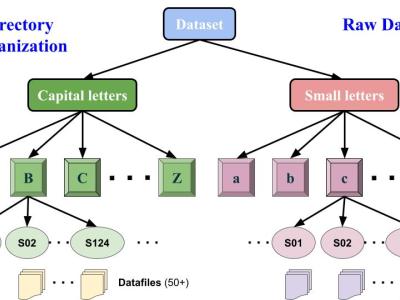A Dataset of Inertial Measurement Units for Handwritten English Alphabets: Leveraging Diversity in Indian Context

- Citation Author(s):
-
Hari Prabhat Gupta ( IIT (BHU) Varanasi)Tanima Dutta ( IIT (BHU) Varanasi)Rahul Mishra ( IIT (BHU) Varanasi)Garvit Banga ( IIT (BHU) Varanasi)Shubham Pandey ( IIT (BHU) Varanasi)Krishna Sharma ( IIT (BHU) Varanasi)Himanshu Sahu ( IIT (BHU) Varanasi)
- Submitted by:
- HARI GUPTA
- Last updated:
- DOI:
- 10.21227/av6q-jj17
- Data Format:
 820 views
820 views
- Categories:
- Keywords:
Abstract
This report presents an end-to-end methodology for collecting datasets to recognize handwritten English alphabets in the Indian context by utilizing Inertial Measurement Units (IMUs) and leveraging the diversity present in the Indian writing style. The IMUs are utilized to capture the dynamic movement patterns associated with handwriting, enabling more accurate recognition of alphabets. The Indian context introduces various challenges due to the heterogeneity in writing styles across different regions and languages. By leveraging this diversity, the collected dataset and the collection system aim to achieve higher recognition accuracy. Some preliminary experimental results demonstrate the effectiveness of the dataset in accurately recognizing handwritten English alphabets in the Indian context. This research can be extended and contributes to the field of pattern recognition and offers valuable insights for developing improved systems for handwriting recognition, particularly in diverse linguistic and cultural contexts. Watch the data collections process on youtube.
Instructions:
During the writing process, a sensor was employed to record data. When the student was actively writing a character, the sensor registered a value of 1, along with other sensory measurements. On the other hand, when the student was not writing a character, the sensor recorded a value of 0, along with the corresponding sensory data. This allowed for the differentiation between active writing periods and non-writing periods. Throughout the dataset collection, the sensors recorded data from all 50 instances of each character being written by the students. This comprehensive data collection approach enabled the capture of multiple repetitions of each character, providing a rich dataset for analysis and modelling purposes. By combining information on the sensory values, timing, and the distinction between writing and non-writing periods, the collected data offers valuable insights into the writing behaviour and patterns exhibited by the students. The sensory dataset is stored in txt files, following the directory hierarchy as shown in Figure.








